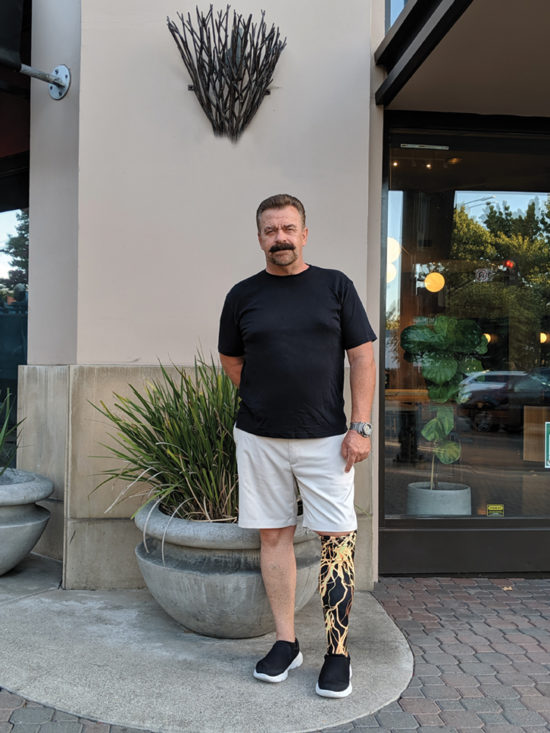By Élan Young
PROSTHETIC COVERS CAN HELP YOU RECLAIM YOUR STYLE
Wearing a prosthesis is functional; wearing a prosthetic cover is art. Prosthetic covers offer amputees and people with congenital limb difference numerous possibilities for flaunting their personal style. While prosthetic limbs tend to bring attention—wanted or not—prosthetic covers can communicate a bit more about how you feel inside.
No amputee can entirely control whether or how others engage with him or her. However, many prosthetic limb users welcome prosthetic covers as a way to have a meaningful connection with strangers while adding a spring in their step. Prosthetic covers can help you walk with more confidence and pride while communicating to others that you embrace your limb difference as something that makes you beautiful and unique rather than limited or deficient.
Today, there are numerous styles available on the market, with a range of prices to meet the needs of the modern prosthetic limb user. From 3D-printed covers to fabric covers, prosthetic limbs can now be decked out with a new design every day to coordinate with any kind of wardrobe. Some of the companies offering prosthetic cover solutions include the following:
ALLELES Design Studio offers a range of unique designs in FDA-grade ABS plastic. Because they are made of ABS plastic, the prosthetic covers are durable, lightweight, flexible, cleanable, and easily modified. These covers are attached with straps that have metal hooks.
ART4LEG provides covers shaped to look like a human leg but with unique 3D-printed designs. Some are printed smooth, and others are patterned with open holes that make them lightweight with interesting design details. These leg covers attach using high-powered magnets for ease of use.
Fred’s Legs offers hand-sewn sleeve covers in dozens of bold designs that are made from high-quality spandex and stretch over the prosthetic limb. The variety of designs and relatively low cost mean many users will select multiple designs to express different moods and styles. The company offers custom designs as well.
Prosthetic Ink offers custom tattoo-inspired painting. The customized pieces can range from solid colors and chrome paint to detailed illustrations. The company has also been experimenting with screen printing to offer lower-priced options.
UNYQ has its own 3D printing facility to offer a range of upper- and lower-limb prosthetic wears. They offer the first smartphone app for creating 3D prosthetic covers.
Francis Zovko is an above-knee amputee who has been wearing prosthetic leg covers from Fred’s Legs for about five years and has about ten different designs. “My favorite is their special edition flag design,” he says. “One of them I have autographed by the rock band Molly Hatchet.” Zovko enjoys talking with others about his amputation, and the covers make it fun for him to go out in public. These covers are easy to wear and quite interchangeable.

Others will gravitate toward a design imprinted or painted directly on the prosthetic limb. Dan Horkey, owner of Prosthetic Ink, believes in leaving the prosthesis exposed so that curious kids or strangers can see it and ask about it. “I played the cover-up game for 20 years, then decided to wear it more openly,” he says. “I was proud of the way it looked with some hot flames, and then I would hear, ‘Dude, that chrome is really shiny!’”
For anyone who has lost a limb that was tattooed, getting the tattoos back offers a way to reclaim their identity and come to greater terms with the loss of a limb.

One of Horkey’s clients is Gina Kothe, a right below-knee amputee since 2013. She opted for a unique pink chrome color on her prosthesis, which is her go-to style when she wears a dress and heels. “People are going to stare anyway,” she says. “Give them something to talk about besides you.” In her experience, wearing a personalized prosthesis provides an opportunity to have an empowering connection with people who might otherwise be focused on asking solely about the reason behind a limb loss, which certainly not everyone wants to share.

So much of the focus on prosthetic limbs is on available technology, which is not in itself a bad thing. However, while the advancements in prosthetic limb technology have been huge, amputees have not had much choice when it comes to adapting a prosthesis to match their own style. So many of the options still center on matching a person’s skin, which is sometimes a way of trying to camouflage the prosthesis.
Fortunately, options exist now to personalize your prosthetic limb and make it stand out as a piece of art. Many people report that this is actually part of their healing and recovery journey. Losing a limb was out of their control, and with that loss of control came feelings of grief. Having the opportunity to choose your style brings agency back and can boost your self-esteem. It also encourages positive interactions with the public by providing a conversation piece that is visually intriguing to people who don’t know about limb loss or prosthetic devices.
FOR MORE INFORMATION
ALLELES Design Studio // www.alleles.ca
ART4LEG // www.art4leg.com
Fred’s Legs // www.fredslegs.com
Prosthetic Ink // www.facebook.com/ProstheticInk
UNYQ // www.unyq.com
WANT TO BE EVEN MORE CREATIVE?
CONSIDER DECORATING OR PAINTING YOUR PROSTHESIS YOURSELF IN YOUR UNIQUE PERSONAL STYLE.
OPAF offers an annual contest called Feet First, which gives participants a chance to paint or decorate a foot shell and show off their talent. Participants request a foot shell, pay a small entry fee, and then return the artwork to auction for OPAF and The First Clinics. This could be a great opportunity to practice your design or painting skills before beginning your personal cover art project.
TOP IMAGE: ninell/stock.adobe.com



